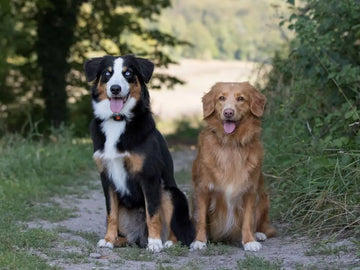Selecting the right color for your dog’s toys may seem minor, but it actually plays a big role in their enjoyment, engagement, and even training. Since dogs perceive colors differently from humans, understanding their unique vision spectrum is key to choosing toys they’ll truly enjoy. This article delves into the science of dog vision, highlights the best color choices for dog toys, and offers tips on choosing toys that are both fun and beneficial for your dog.
Understanding Dog Vision
Dogs experience the world through a different visual lens than humans. Unlike our trichromatic vision, which allows us to see a full spectrum of colors, dogs have dichromatic vision. This means they only have two types of color-detecting cells (cones) in their eyes, primarily allowing them to see shades of blue and yellow. While they cannot fully perceive colors like red and green, their vision is uniquely adapted to detect movement and contrast, which can still make playtime thrilling.
The Color Spectrum Dogs Perceive
Dogs can distinguish between blue and yellow but struggle with red, green, and similar colors. These hues appear as muted shades of gray or brown, making them harder for dogs to identify against various backgrounds. For example, a bright red ball may look exciting to humans but blends in with grass and soil for dogs, reducing visibility. This understanding is essential when selecting toys, as visibility and color contrast directly affect a dog’s engagement with the toy.
Why Color Matters in Dog Toys
The color of a toy impacts how your dog interacts with it. Colors that stand out in their visual spectrum, like blue or yellow, are more likely to catch their attention and stimulate curiosity. Dogs rely on visual cues to locate toys during play, so colors they can easily detect improve their experience. Furthermore, color choices can support training, reinforce positive behaviors, and make retrieving toys more manageable, especially in complex environments.
The Best Colors for Dog Toys
For maximum engagement, choose toys in blue and yellow hues. These colors stand out against various backgrounds, whether you’re playing indoors or outdoors.
- Blue Toys: The color blue is highly visible to dogs, even in outdoor settings with green grass or brown soil, making it an ideal choice for fetch toys or outdoor playtime.
- Yellow Toys: Yellow toys provide another great option. This color offers contrast against indoor surfaces and outdoor landscapes, helping your dog spot the toy easily.
Colors to Avoid in Dog Toys
Avoid choosing toys that are primarily red, green, or shades between these colors. Since dogs struggle to differentiate red from green, toys in these colors are often less visible to them, especially on natural terrains. A red ball on green grass might be practically invisible to your dog, causing frustration during fetch games or outdoor training sessions.
Impact of Toy Color on Dog’s Mood
Interestingly, the color of a toy can even influence a dog’s energy levels. Blue toys can have a calming effect, while yellow may create excitement, making these colors suitable depending on the activity. For example, blue toys can be effective for winding down, whereas yellow toys may be better suited for stimulating and active play sessions.
Color Contrast in Outdoor Settings
For outdoor play, color contrast is crucial. Blue and yellow toys contrast effectively with natural elements, ensuring that the toy is both visually stimulating and easy to locate. By choosing contrasting colors, you create a more engaging play environment that encourages exploration, chase, and retrieval.
Indoor vs. Outdoor Toys: Color Choices
When selecting toys for indoor play, yellow is typically more effective because it stands out against flooring and furniture. Outdoors, however, blue often outshines yellow since it contrasts better against green grass and earth tones, making it easier for dogs to see from a distance. When shopping for pet supplies, you’ll often find color-coded toys for both indoor and outdoor use, helping owners select the best hues for different environments.
Interactive Dog Toys and Color Choices
Interactive dog toys provide mental stimulation, which is essential for a well-rounded play experience. When choosing these types of toys, consider ones in high-contrast colors like blue and yellow to keep your dog engaged. Interactive toys, especially treat-dispensing puzzles, are more effective when their color aligns with your dog’s visual strengths, making it easier for them to focus on the task. This small detail can make a big difference in how much enjoyment your dog gets from these toys.
Best Dog Toys by Color and Purpose
The best dog toys combine color with durability and safety. Look for options in blue and yellow that can withstand chewing, tugging, or fetching, depending on your dog’s play style. Chew toys, for instance, may work better in bright, high-contrast colors, while softer plush toys can also benefit from a dog-friendly color palette. Matching toy colors with your dog’s play habits helps enhance their engagement and satisfaction during playtime.
Conclusion
Choosing the right color toys for your dog makes a significant difference in their enjoyment, visibility, and engagement. By understanding canine color perception, you can select toys in shades that maximize playtime and minimize frustration. Opt for vibrant blue and yellow toys that suit your dog’s play style and needs, ensuring an enriching and safe experience for your furry friend.










